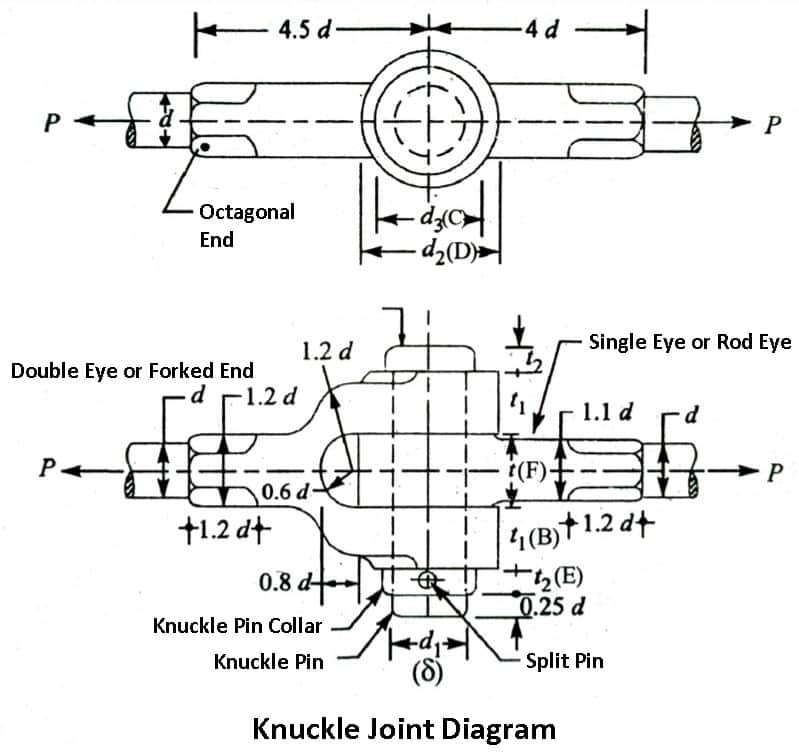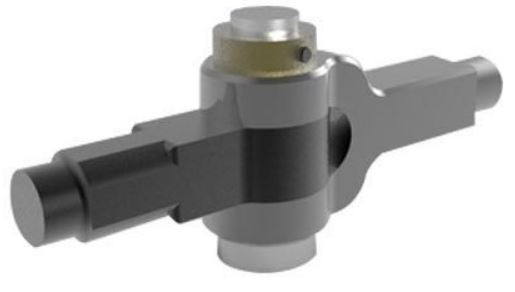In this article, you’ll learn what is Knuckle Joint? how does it work? Its diagram, parts, functions, and more explained in detail with diagrams.
Furthermore, you can download the PDF file of this article at the end.
What is Knuckle Joint?
A knuckle joint is used to join two rods which are subjected to the action of tensile loads. However, if the joint is directed, the rods can support compressive loads. A knuckle joint can be easily disconnected for adjustment or repair.
Typically, these types of joints are used in bicycle chain links, tie rod joints for roof trusses, valve rod joints with centric rods, pump rod joints, tension links in bridges, and also found in a variety of lever and rod connections.
One end of the rod forms into the eye and the other end of the rod forms a fork, with an eye in each fork. The knuckle pin slightly passes through both the eye and fork hole and it is achieved with a collar and taper pin.
A small stop, pin, peg, or snug can prevent the knuckle pin from rotating into the fork. To obtain a better quality of the joint, the edges of the fork and eye are machined, the holes are drilled accurately and the pins are rotated. The material used to make the joint may be steel or iron.
Read Also: What are the Applications of a Cotter Joint? [Explained with PDF]
Parts of a Knuckle Joint
Following are the main parts of a knuckle joint:
- Two rods
- Double-eye end or fork end
- Single eye end
- Knuckle pin
- Collar
- Taper pin

Read Also: What are the different types of fasteners commonly used? [PDF]
1. Two rods
It usually requires two rods to connect the knuckle joint. In which one rod has one end of the eye while the other has two ends like a fork.
2. Double-eye End or Fork End
This double-eye end usually consists of two ends and has a shape like a fork. Because one end is for entering the knuckle pin and the other for the collar in which the taper pin is put so that this joint does not open.
3. Single-eye End
The single eye end is placed between the double eye end of the two holes in such a way that all the 3 holes (2 holes of the double eye end and 1 hole of the single eye end) are together.
4. Knuckle Pin
Now, the knuckle pin is passed through these holes and joins them together very tightly. Usually, there is a small hole at the end of the knuckle pin to insert the taper pin.
5. Collar
It has a collar with a two-hole for passing the taper pin. The collar is placed at the end of the knuckle pin in such a way that the hole meets the hole at the knuckle joint.
6. Taper Pin
After that, a taper is passed through the hole of the collar to secure the collar and knuckle pins and prevent them from slipping. In this way, the knuckle joint can be made.
Materials Used To Make Knuckle Joint
Knuckle joints are normally made of materials like aluminum, stainless steel, structural steel, magnesium, and cast iron. It has been found that knuckle joints made of aluminum have the highest safety factor of about 50 kN loading conditions.

Joints used in some industries are usually made from a combination of cast iron and stainless steel. As technology advances in recent decades, material costs and weight have decreased, resulting in reduced accidents and increased safety.
Recently discovered that if you use composite material instead of cast iron, It has many advantages such as easy-to-make knuckle joints, maximum safety, and eco-friendly. You can easily cast or fabricated and forged the knuckle joint.
Methods of Failure of Knuckle Joint
In learning the strength of the joint for different methods of failure, it is found that,
- There is no stress concentration, and
- The load is distributed evenly over each part of the joint.
Because of these assumptions, the strengths are approximate. But, they help to indicate a well-proportioned addition. Following are the different methods of joint failure.
- This is because of failure of the solid rod under tension and failure of the knuckle pin in shearing load.
- Due to the failure of single eye or rod end in tension and shearing loads.
- This is because of the failure of single eye or rod end in crushing and failure of forked end in tension load.
- It is due to the failure of the forked end in shear and crushing loads.
Applications of Knuckle Joint
By the way, Knuckle joints work in many places and they are also used in big industries. These are applied between the tie rod joint of a roof truss and the joint tension link in a bridge structure.
Mostly knuckle joints are employed in connecting rods of locomotive wheels. In addition, they are very useful in the valve mechanism of a reciprocating engine. These are utilized in the link of roller chain, bicycle chain, and chain straps of watches.
Knuckle joints are also applied on the rod joint of the jib crane and the fulcrum of the lever. These types of joints are used in the alignment parts of a tractor wheel. If we talk about automobiles, a knuckle is supporting the skeleton for the wheel assembly.
It is used for downhole stringing on some occasions such as flush eccentric work barrel stage, lateral drilling, re-entry into the bottom of the well, fishing, and more. They are mainly applied to connect coaches of the train.
In addition, knuckle joints are commonly used in vehicle windshield wipers and are also used in robotic arms or earthmovers such as cranes or tanks, etc.
Advantages of Using Knuckle Joint
Following are the advantages of using knuckle joint:
- Knuckle joints have the ability to withstand high tensile loads.
- It can give you high repeating accuracy even with varying material thickness and tensile strength.
- They provide excellent mechanical rigidity.
- They are simple in construction and easy to install.
- The knuckle joint is easily assembled and disassembled.
- The construction design of the knuckle joint is easy to manufacture.
- Fewer parts of this joint are less expensive and more reliable.
- This allows angular momentum between rods and is mostly provided for longer tool life.
Disadvantages of Knuckle Joint
Knuckle joints give most of the benefits but they also have some drawbacks, which are as follows:
- The ability to withstand large compressive loads is not much in knuckle joints.
- It gives you angular momentum but only in one plane. It’s one of their shortcomings.
- You may have used a universal joint to see how flexible they are, but the knuckle joint doesn’t have that flexibility.
Conclusion
A knuckle joint is a mechanical joint employed to connect two rods under tensile loads when a small amount of flexion or angular moment is required. Now, I hope that you have learned about the “knuckle joint” and its different parts and working.
If you have any questions or doubts regarding this article, you can ask in the comments. If you liked this article, then please share it with your friends.
Want Free PDFs sitting at home? Then Subscribe to our newsletter.
Download the PDF file of this article:
Read about machines in our blog:
- What are the Types of Power Hammers Used in Forging?
- 12 Different Types Of CNC Machine [Explained In Detail] With PDF
- Jig Boring Machine: Parts, Working, Types, Operations, and Uses
Frequently Asked Questions
Mostly knuckle joints are employed in connecting rods of locomotive wheels. In addition, they are very useful in the valve mechanism of a reciprocating engine. These are utilized in the link of roller chain, bicycle chain, and chain straps of watches.
Advantages of the knuckle joint:
1. They are easy to assemble and disassemble.
2. The design of the joint is very simple to understand.
3. These joints are easy to manufacture.
4. They provide excellent mechanical rigidity.